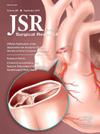Under Pressure: Rapid Infusion of Stored Whole Blood Alters Coagulation Parameters
IF 1.7
3区 医学
Q2 SURGERY
引用次数: 0
Abstract
Introduction
The use of normothermic rapid transfusers to deliver high volumes of warmed blood products to hemorrhaging patients is common practice. However, the effects of these transfusers on the coagulation profile of stored compared to fresh whole blood has not been studied.
Methods
Units of fresh whole blood and blood stored for 21 days were acquired from our local blood bank. Rapid infusion was simulated using a Level 1 H-1200 at 42°C and 300 mmHg of pressure. Samples were taken preinfusion and postinfusion and examined for cell counts, biochemical changes, viability, viscoelastic properties, and microvesicle concentrations.
Results
Fresh whole blood was unaffected by rapid infusion in all end points. In contrast, rapid infusion of stored whole blood resulted in significantly higher levels of free hemoglobin (63 ± 25 mg/mL preinfusion to 101 ± 41 mg/mL postinfusion, P = 0.0025), decreased platelet contribution to clot (73 ± 5% to 66 ± 6%, P = 0.0075), decreased platelet aggregation (10.1 ± 5.5 to 6.0 ± 3.7 area under the curve with arachidonic acid, P = 0.03), and increased platelet derived microvesicles (164 ± 151 to 260 ± 163 events/μL, P = 0.01). Platelet and platelet microvesicle concentrations expressing CD62 in stored whole blood remained unchanged postinfusion (P > 0.05).
Conclusions
Infusion of stored whole blood via a rapid infuser resulted in hemolysis, platelet dysfunction, and increased platelet-derived microvesicles. We suspect that platelet destruction due to pressurized infusion leads to an increase in microvesicle concentration and a subsequently altered coagulation profile.
压力下:快速输注储存的全血改变凝血参数
使用常温快速输血器向出血患者输送大量温热血液制品是常见的做法。然而,与新鲜全血相比,这些输血者对储存全血凝血特性的影响尚未研究。方法采集本地血库新鲜全血和保存21 d的血液。采用1级H-1200在42°C和300 mmHg压力下模拟快速输注。在输注前和输注后采集样本,检测细胞计数、生化变化、活力、粘弹性和微泡浓度。结果各终点新鲜全血不受快速输注的影响。相比之下,快速存储全血的注入导致了更高水平的游离血红蛋白(63±25毫克/毫升preinfusion postinfusion 101±41毫克/毫升,P = 0.0025),减少血小板凝块贡献(73±5%至66±6%,P = 0.0075),减少血小板聚集(10.1±5.5,6.0±3.7曲线下面积与花生四烯酸,P = 0.03),并增加血小板衍生的微泡(164±151到260±163事件/μL, P = 0.01)。储存全血中表达CD62的血小板和血小板微泡浓度在输注后保持不变(P > 0.05)。结论通过快速输注器输注储存的全血可导致溶血、血小板功能障碍和血小板源性微泡增加。我们怀疑,加压输注引起的血小板破坏导致微囊泡浓度增加,并随后改变凝血特征。
本文章由计算机程序翻译,如有差异,请以英文原文为准。
求助全文
约1分钟内获得全文
求助全文
来源期刊
CiteScore
3.90
自引率
4.50%
发文量
627
审稿时长
138 days
期刊介绍:
The Journal of Surgical Research: Clinical and Laboratory Investigation publishes original articles concerned with clinical and laboratory investigations relevant to surgical practice and teaching. The journal emphasizes reports of clinical investigations or fundamental research bearing directly on surgical management that will be of general interest to a broad range of surgeons and surgical researchers. The articles presented need not have been the products of surgeons or of surgical laboratories.
The Journal of Surgical Research also features review articles and special articles relating to educational, research, or social issues of interest to the academic surgical community.

 求助内容:
求助内容: 应助结果提醒方式:
应助结果提醒方式:


